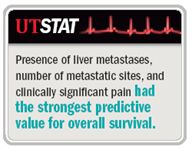Article
Nomogram predicts survival in hormone-refractory prostate cancer
New research has identified a number of independent predictors of overall survival in men with metastatic hormone-refractory prostate cancer, and those findings have been used to generate a simple nomogram for predicting survival probability to 5 years.

"This is the first nomogram for predicting survival in this patient population going out to 5 years, and while it is not perfect, we believe it represents an easy-to-use tool for bedside prognostication or for patient stratification in clinical trials," said Dr. Armstrong, assistant professor of medicine, division of medical oncology, Duke University, Durham, NC. "We have already validated the nomogram internally using bootstrap methods, and were very pleased to find it had a reasonably high concordance index of 0.69, which is similar to previous models. We now plan to validate the new nomogram externally in prospective trials to support its wider use."
The prognostic model was developed using data from TAX 327, a multicenter clinical trial of 1,006 men with metastatic hormone-refractory prostate cancer (N Engl J Med 2004; 351:1502-12). In that study, men were randomized to one of three treatment arms: docetaxel, 75 mg/m2 every 3 weeks; docetaxel, 30 mg/m2 weekly for 5 of every 6 weeks; or mitoxantrone (Novantrone), 12 mg/m2 every 3 weeks. All men also received prednisone (Deltasone, Meticorten, Orasone, et al), 5 mg twice daily.

Prognostic ability of PSADT
Median PSA doubling time (PSADT) at baseline was 55 days and was similar among the three treatment groups. Using men with a PSADT <1 month as a reference, the investigators found a decreasing risk of death as PSADT lengthened; the relative hazard for death was 0.79, 0.69, 0.53, and 0.37 for men with a PSADT of 1 to 2 months, 2 to 3 months, 3 to 6 months, and >6 months, respectively (p<.001 for trend).
"Previous studies have shown PSADT to be prognostic in this setting, but they were underpowered to show a true independent effect because they had small sample sizes and used retrospective databases. Our study confirms the previous reports, but represents the first independent multivariate indication of the prognostic ability of PSADT in this disease state," Dr. Armstrong noted.
Cox regression analysis was used to identify baseline clinical and biomarkers that predicted overall survival. Variables determined to have independent prognostic value were clinically significant pain (Analgesic Score ≥10 or Present Pain Inventory score ≥2), presence of liver metastases, number of metastatic sites, Karnofsky Performance Status, type of progression, absolute PSA, PSADT, tumor grade, alkaline phosphatase, and hemoglobin.
Of those variables, presence of liver metastases, number of metastatic sites, and clinically significant pain had the strongest predictive value. Hazard ratio values for those factors ranged from 1.46 to 1.64.
"While many of the variables included in this nomogram are also found in prior tools, the factors we found to be the most significant predictors of mortality are also unique to our nomogram. It is also notable that this nomogram is derived from data collected in a very large trial of patients treated with a modern chemotherapy regimen. Prior nomograms were validated in the pre-docetaxel era, so their utility in patients treated with a current chemotherapy approach is unclear," Dr. Armstrong said.
In the new nomogram, each of the prognostic variables is assigned a point value. The total number of points can be used to estimate median survival time or survival probability after 1, 2, or 5 years.





